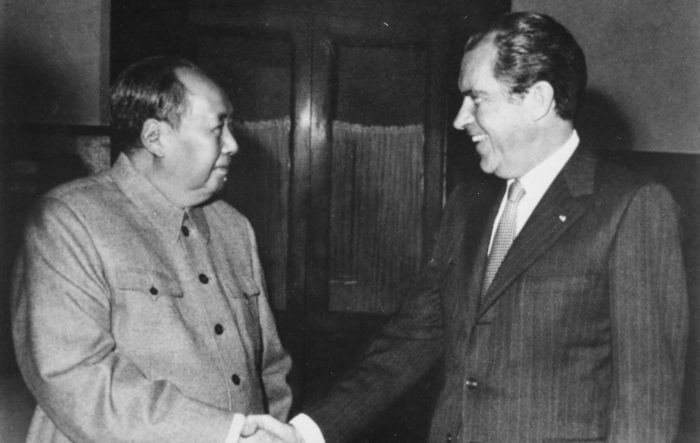A 'Reverse Kissinger' in India
India provides the U.S. with an opportunity to engage in discreet diplomacy with Russia.

As the Western alliance scrambled to present a united response to Russia’s invasion of Ukraine, President Joe Biden made it a point to single out India as being “somewhat shaky” in its stance on the war. Just prior to the invasion, the U.S. threatened India with sanctions unless it agreed to downgrade substantial and long-standing defense and diplomatic ties with Russia. This followed a sustained pattern of U.S. pressure on India to move away from its traditional global non-alignment in favor of aligning more closely with the West.
Washington should consider instead whether the partnership between India and Russia might further U.S. global interests and objectives given the greater challenges posed by China. What is more, India might be the key to executing a “reverse Kissinger,” with Russia—a diplomatic reopening at a time when tensions with the West are at their highest since the dissolution of the Soviet Union.
India has emerged as a critical security partner for the U.S. in the face of the looming threat of Chinese hegemony in Asia. Its participation and potential contributions to the Quad will be essential for any plausible anti-hegemonic coalition seeking to counter Chinese designs against an open Indo-Pacific. India’s sheer size and potential mean the country will inevitably play a pivotal role in the global balance of power. It will be the central regional player in the geopolitical contest over Asia. Yet U.S. policymakers have adopted an increasingly confrontational and even condescending posture toward what could be the world’s next emerging great power.
The tensions in the relationship have mostly revolved around U.S. opposition to India’s traditional non-alignment and the U.S.'s pressuring India to end its long-standing relationship with Russia. The latter began with U.S. threats to sanction India for continuing to acquire arms from Russia. This has evolved into an overarching narrative, according to which New Delhi is expected to provide effectively unconditional support for every political stance or policy decision the U.S. adopts towards Russia and Europe, regardless of India’s national interests.
This occurs at a time when defense cooperation between the U.S. and India, including the Quad, remains in a rudimentary stage, even while Washington’s own attention on the Indo-Pacific has been consistently diverted to more familiar but secondary matters like NATO and Europe.
The problem of this gap in trust between the U.S. and India is compounded by persistent power asymmetries between India and China. India does not yet have the ability to counter or challenge China on its own. Its domestic defense-industrial base has not developed anything close to the same capacity as China's. India’s military is thus highly reliant on arms imports from Russia. The decision to arm Ukraine, meanwhile, has revealed deep problems in the U.S. defense sector—turning to the “arsenal of democracy” would not be a realistic alternative for India.
Given these circumstances, U.S. confrontation with India over Russia runs directly counter to the interests of both countries. Washington should recognize instead that a continuing partnership between India and Russia could further U.S. objectives in countering China’s rise, especially at a time when relations between Washington and Moscow are at their lowest point since the end of the Cold War. Insisting on India’s estrangement from a long-standing security partner and its involvement in distant and peripheral conflicts does little to further U.S. or Indian interests in countering the far more urgent challenge posed by China.
Further, given the risk of the West pushing Russia into permanent alignment with China, as Henry Kissinger has recently warned, it is also critical that a country as large and influential as India remains a diplomatic option for the Kremlin. A declining and isolated Russia that must become, in effect, a client state for a rising and predatory China could have deeply adverse consequences for equilibrium on the Eurasian landmass. Even if there is no rapprochement between Russia and the Western alliance in the foreseeable future, a stable and independent relationship between Russia and India would remain critical to the global balance of power.
Subscribe Today
Get daily emails in your inbox
Given how much controversy is engendered by suggestions that the U.S. and NATO reach a settlement with Russia, India could provide an opportunity for Washington to engage in discreet diplomacy. This could be the “reverse Kissinger” for our time.
Consider how, before Nixon and Kissinger visited Beijing, Mao’s China was an international pariah responsible for atrocities on a scale unseen since Hitler and Stalin. China had also intervened at various times in Korea, Vietnam, and Cambodia in support of communist regimes. Yet China remained structurally impossible to ignore and exclude from the international system while it was the USSR’s global ambitions, not Mao’s actions at home or in his near abroad, that posed the most dangerous and imminent challenge for the U.S. at the time.
To avoid the controversy that would have been inevitably associated with reaching out to China directly—and given the lack of trust and communication between Beijing and Washington—Nixon and Kissinger went through Pakistan, the only common ally between the U.S. and China at the time. This historical precedent should inform U.S. policy towards India’s relationship with Russia. It is not only sound for India to retain its defense and diplomatic ties with Russia, but could also be a future diplomatic opportunity for Washington and Moscow. The U.S. would thus avoid alienating a key security partner in India while providing Russia a plausible alternative to becoming a vassal of China.
Comments